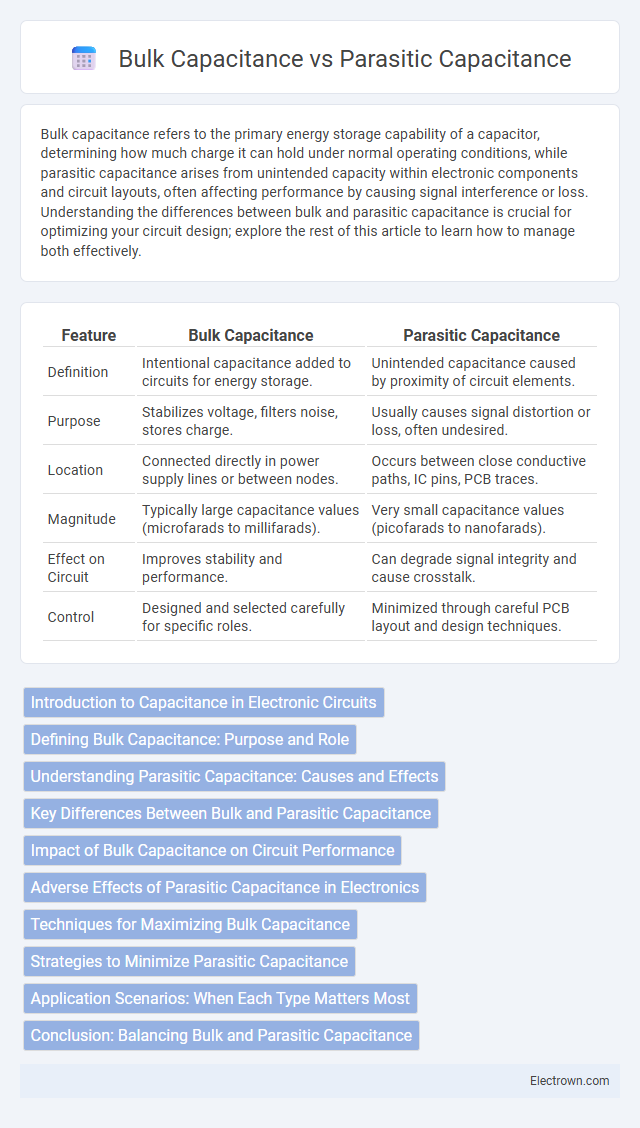Bulk capacitance refers to the primary energy storage capability of a capacitor, determining how much charge it can hold under normal operating conditions, while parasitic capacitance arises from unintended capacity within electronic components and circuit layouts, often affecting performance by causing signal interference or loss. Understanding the differences between bulk and parasitic capacitance is crucial for optimizing your circuit design; explore the rest of this article to learn how to manage both effectively.
Table of Comparison
| Feature | Bulk Capacitance | Parasitic Capacitance |
|---|---|---|
| Definition | Intentional capacitance added to circuits for energy storage. | Unintended capacitance caused by proximity of circuit elements. |
| Purpose | Stabilizes voltage, filters noise, stores charge. | Usually causes signal distortion or loss, often undesired. |
| Location | Connected directly in power supply lines or between nodes. | Occurs between close conductive paths, IC pins, PCB traces. |
| Magnitude | Typically large capacitance values (microfarads to millifarads). | Very small capacitance values (picofarads to nanofarads). |
| Effect on Circuit | Improves stability and performance. | Can degrade signal integrity and cause crosstalk. |
| Control | Designed and selected carefully for specific roles. | Minimized through careful PCB layout and design techniques. |
Introduction to Capacitance in Electronic Circuits
Capacitance in electronic circuits stores and releases electrical energy, essential for filtering and signal smoothing. Bulk capacitance refers to the designed capacitance value provided by components like electrolytic capacitors, influencing circuit stability and energy storage. Parasitic capacitance arises unintentionally from component leads, circuit layout, and nearby conductors, potentially causing signal distortion and limiting high-frequency performance.
Defining Bulk Capacitance: Purpose and Role
Bulk capacitance refers to the large-value capacitors designed to stabilize voltage and provide energy storage in electronic circuits, primarily smoothing out voltage fluctuations and supplying current during transient loads. It plays a crucial role in power supply systems by maintaining steady voltage levels and improving overall circuit performance. Your electronic design benefits from bulk capacitance by ensuring reliable operation and reducing noise caused by sudden changes in power demand, unlike parasitic capacitance which is unintended and often detrimental.
Understanding Parasitic Capacitance: Causes and Effects
Parasitic capacitance arises from unintended electric fields between circuit elements, often caused by close proximity of conductive parts, PCB layout, and component packaging. These stray capacitances can introduce signal distortion, noise, and affect the performance of high-frequency circuits by causing timing errors and crosstalk. Unlike bulk capacitance, which provides energy storage and voltage smoothing, parasitic capacitance is an undesirable byproduct that engineers must minimize through careful design and layout optimization.
Key Differences Between Bulk and Parasitic Capacitance
Bulk capacitance refers to the intentional storage of electrical charge within capacitors designed to stabilize voltage and filter noise in circuits, characterized by high capacitance values typically measured in microfarads or higher. Parasitic capacitance, on the other hand, is the unintended and often detrimental capacitance that exists between circuit elements due to their proximity, typically exhibiting very low capacitance values in the picofarad range. Understanding these key differences is crucial for optimizing your circuit design, as bulk capacitance enhances performance by storing energy, whereas parasitic capacitance can cause signal distortion and reduce overall efficiency.
Impact of Bulk Capacitance on Circuit Performance
Bulk capacitance significantly influences circuit stability by providing a reservoir of charge that smooths voltage fluctuations and reduces noise. High bulk capacitance enhances power supply decoupling, ensuring reliable operation of sensitive components and minimizing voltage dips during transient loads. Optimizing your circuit's bulk capacitance improves overall performance and operational stability, especially in power-sensitive applications.
Adverse Effects of Parasitic Capacitance in Electronics
Parasitic capacitance in electronics causes signal distortion, reduced circuit speed, and increased power consumption, impairing overall device performance. Bulk capacitance, typically provided by larger capacitors, stabilizes voltage levels and filters noise, contrasting sharply with the unintended and often detrimental effects of parasitic capacitance. Managing parasitic capacitance is crucial for high-frequency circuits to prevent interference and maintain signal integrity.
Techniques for Maximizing Bulk Capacitance
Maximizing bulk capacitance involves selecting capacitors with higher dielectric constants, increasing the electrode surface area, and using materials with low equivalent series resistance (ESR) to enhance energy storage capabilities. You can also optimize bulk capacitance by employing multi-layer ceramic capacitors (MLCCs) or electrolytic capacitors designed for high capacitance values. These techniques reduce the impact of parasitic capacitance, which arises from undesired capacitances within the circuit and can limit overall performance.
Strategies to Minimize Parasitic Capacitance
Strategies to minimize parasitic capacitance include careful PCB layout design by increasing the distance between conductive traces and using grounded shielding to reduce capacitive coupling. Selecting low-dielectric constant materials and minimizing the overlap area between conductors further decreases unwanted capacitance. Using surface-mount components with shorter lead lengths also helps reduce parasitic effects compared to bulk capacitance in power electronics.
Application Scenarios: When Each Type Matters Most
Bulk capacitance is crucial in power supply filtering and energy storage applications where large charge reservoirs stabilize voltage during high load demands. Parasitic capacitance becomes significant in high-frequency circuits and sensitive analog systems, where unintended capacitances can cause signal distortion, timing errors, or noise coupling. Designers prioritize bulk capacitance in power electronics and parasitic capacitance mitigation in RF, high-speed digital, and precision analog circuits.
Conclusion: Balancing Bulk and Parasitic Capacitance
Balancing bulk capacitance and parasitic capacitance is essential for optimizing circuit performance, as bulk capacitance stores significant energy for power stability while minimizing parasitic capacitance reduces unwanted signal interference. Your circuit design should aim to maximize effective bulk capacitance to maintain voltage stability while carefully managing parasitic capacitance through layout techniques and component selection. Achieving this balance ensures reliable operation and improved electromagnetic compatibility in electronic systems.
Bulk capacitance vs Parasitic capacitance Infographic

 electrown.com
electrown.com